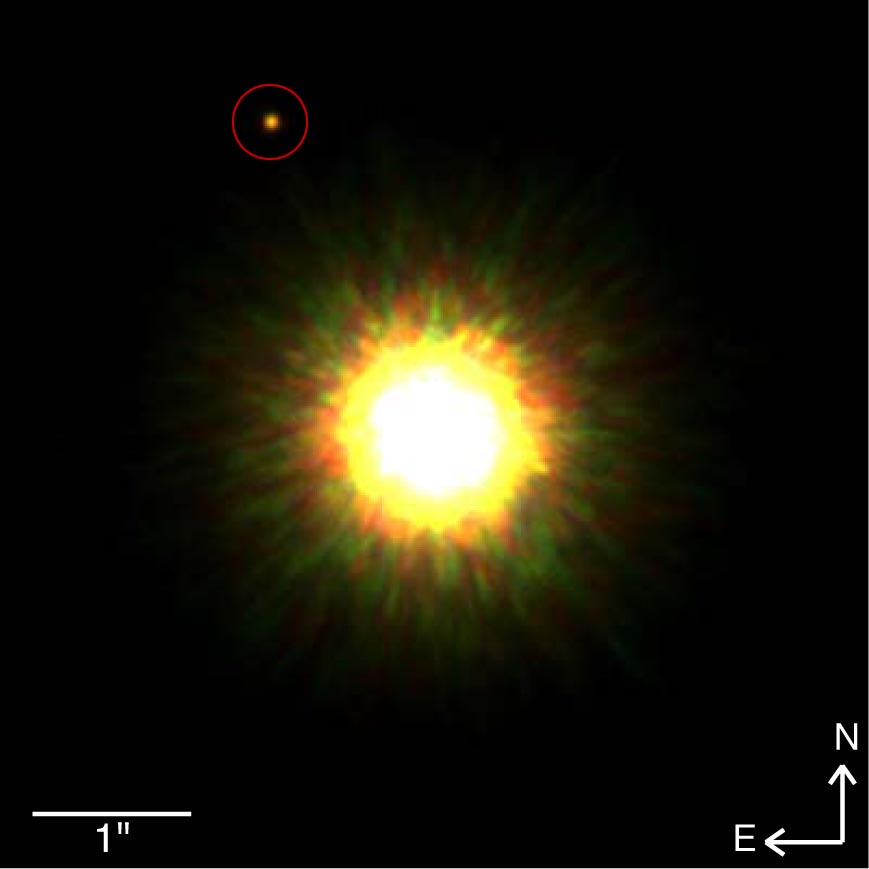







| BOOKS | F. A. Q. | ARTICLES | TALKS | ABOUT KEN | DONATE | BEYOND OUR KEN |
|---|
By Ken Croswell
Published on ScienceNOW (February 21, 2012)

Far-out find. This young star in the constellation Scorpius may have captured its planet (circled), which is more than 330 times farther from its star than Earth is from the Sun.
Credit: Gemini Observatory. David Lafrenière, Ray Jayawardhana, and Marten van Kerkwijk.
Some people reach for the stars, but the stars themselves seem to be reaching for the planets. Although Earth and its planetary neighbors were born with the Sun, a new study says billions of stars in our Galaxy likely grabbed planets from the depths of space. The finding may explain the puzzling presence of worlds located far from their suns and even suggests that our solar system could harbor a planet that lurks unseen well beyond Pluto.
Planets form from a disk of gas and dust orbiting a star and so should not exist beyond the disk's edge. In recent years, however, astronomers have reported giant planets more than 100 Sun-Earth distances from their stars--much farther out than Pluto, whose mean distance from the Sun is 39.5 times greater than Earth's.
Now astronomers Hagai Perets of the Harvard-Smithsonian Center for Astrophysics in Cambridge, Massachusetts, and Thijs Kouwenhoven of the Kavli Institute for Astronomy and Astrophysics at Peking University in China say the far-out planets once roamed space free of any star, but they came in from the cold when their newfound suns captured them. Such free-floating planets arise when other planets kick them out of their homes; astronomers can detect them because their gravity magnifies the light of more distant stars. These observations suggest free-floating planets are roughly as abundant as stars.
Because most stars are born with others, Perets and Kouwenhoven ran computer simulations to see what happens when a star cluster contains free-floating planets. As the scientists report in work submitted to The Astrophysical Journal, if the number of free-floating planets equals the number of stars, then 3 to 6 percent of the stars succeed in capturing a planet, and some stars capture two or three. Most of the captured planets end up hundreds or thousands of times farther from their stars than Earth is from the Sun. Furthermore, most captured planets have orbits tilted to those of native-born planets, and half the captured planets revolve around their stars backward.
"It's an intriguing suggestion to account for an unsolved puzzle," says astronomer Ray Jayawardhana of the University of Toronto in Canada. He cautions, though, that the number of free-floating planets is poorly known. Gregory Laughlin, an astronomer at the University of California, Santa Cruz, echoes this concern but says that if free-floating planets are common, the new work is probably correct.
The more mass a star has, the greater its gravity and the greater its chance of catching a passing planet. "Black holes could host planets," Perets says. A black hole forms when a massive star explodes and collapses. The rapid mass loss liberates any orbiting planets, but a black hole is so massive it can capture other worlds, he says.
Our Sun is more massive than most other stars. "The Sun itself could have captured another planet," says Perets, who puts the odds of such a capture at a few percent. Any captured world must revolve so far beyond Pluto that its gravity does not perturb the known planets.
Far out indeed!
Ken Croswell is an astronomer and the author of The Lives of Stars.
"A stellar picture of what we know or guess about those distant lights."--Kirkus. See all reviews of The Lives of Stars here.
| BOOKS | F. A. Q. | ARTICLES | TALKS | ABOUT KEN | DONATE | BEYOND OUR KEN |
|---|